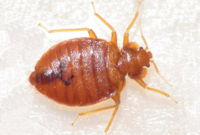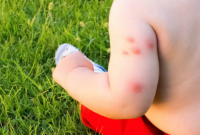Bed bugs are most commonly discovered on your bedding or hiding close by. Areas they prefer to live in include your bed frame, box spring, and especially on your mattress. Since bed bugs are just ¼ of an inch long, they do not occupy much space on their own. This makes it possible for a big colony to make its nest in a mattress.
As a nocturnal species, bed bugs will come out at night to feed. Usually, they target the upper torso or other exposed areas of skin. They Bite along the neck, shoulders, and arms. For easier access to those areas, bed bugs are more likely to nest where the mattress meets the headboard. If you suspect that your mattress is infested, it is best to understand how to identify those creatures. So, how exactly can you tell if bed bugs are residing around your mattress or bed? Keep reading the following text to get its explanation.
What Do Bed Bugs Look Like on Your Mattress?

Although they are very tiny, bed bugs will still stand out on your mattress. They are reddish-brown in color, and approximately the size of a pumpkin seed. It is rare to find bed bugs roaming around on their own. If you find only one bed bug, it is like a colony is nearby.
The colony will consist of the below types of bed bugs:
- Mature adults
- Larvae
- Nymphs (will regularly shed their skin)
- And unhatched eggs
Can Bed Bugs Live on the Air Mattresses?
Bed bugs are adaptable insects. They are capable of living in nooks or crannies they come across. Thus, bed bugs will be able to live in an air mattress. But air mattresses are not as suitable for bed bugs as normal mattresses are. This is due to most air mattresses being created of vinyl and PVC that makes it harder for bed bugs to burrow inside them. The lack of other bedding components are box springs and headboards. Also, it makes bed bugs valuable hiding places. It is also much easier to bed bug-proof an air mattress than a regular mattress. Plastic covers are able to be placed over an air mattress, trapping any bed bugs inside and keeping more bed bugs out. Whereas regular mattresses will need a special bed bug encasement.
Signs of Bed Bugs on Your Mattress
There are some indicators that bed bugs are living inside your bedding or mattress. The most obvious sign is finding an active insect scurrying across. Also, you might notice rust-colored stains dotting your mattress. Actually, these stains are dried bloodstains. This was able to be blood which was left behind after a feeding, or the remains from bed bugs that crushed in your sleep.
You have to know that Bed bugs are not fast travelers. So, it is easy for you to roll over them while you toss and turn. Also, there might be darker stains present in the mattress, approximately the size of a bullet point. Those spots are bed bug feces that can bleed through the fabric and will leave permanent stains if left unwashed.
Usually, bed bugs defecate during feeding sessions. In fact, they are going to make excrement when feeding to make room for new food in their digestive system. If you find translucent, pearl-like objects or pale-yellow skins, then you have evidence of the bed bugs reproducing. The former is a sign of the bed bug eggs that hatch about 1 week after they are laid. Meanwhile, the skins are shed from bed bug nymphs. This skin indicates that the larvae are maturing. For your information, a female bed bug lays an average of one to three eggs per day. After a larva hatches, it is going to fully mature after five weeks.
What to Spray on Your Mattress for Bed Bugs?
If you are looking for a quick solution to remove bed bugs, the mind immediately thinks of insecticides. But, remember that chemical pesticides contain some toxic ingredients which can cause health issues in humans with enough exposure. To spray on your mattress, biopesticides are the best product to use. Biopesticides are able to be best described as natural scents which are harmful to bed bugs, however are safe to humans.
Here are some examples of biopesticides you can use to remove bed bugs:
- Citrus
The smell of citrus fruits, like oranges or lemons, is detrimental to all types of insects. Like other insects, Bed bugs are highly sensitive to the smell of citrus. Prolonged exposure would be able to disturb their ability to spread. - Cinnamon
Also, cinnamon has a strong scent. There is another reason why bed bugs hate it. It contains a compound named eugenol which gives cinnamon its flavor. Aside from that, eugenol is also an ingredient in chemical pesticides, making it highly effective against bed bugs. - Lavender
Humans discover the scent of lavender to be relaxing, but to bed bugs, it is the furthest thing from calming. Lavender consists of a compound named linalool which like eugenol, is also discovered in most insecticides.
Baking Soda on Mattress for Bed Bugs
Baking soda is an effective agent to kill bed bugs. If a bed bug ingests baking soda, then the chemicals inside the baking soda are going to form carbon dioxide gas. The gas will eat away at the protective lining inside the bed bug’s stomach, and then kill them from the inside. Walking over baking soda makes the bed bug at risk of getting trapped in its exoskeleton. The soda particles are going to cut through the bug’s underbelly or dissolve through the top of the exoskeleton, causing death slowly.
Also, baking soda will absorb all the water out of a bed bug’s system, finally causing death from dehydration. If bed bugs are observed lurking around a mattress, you are able to sprinkle some baking soda around areas where they travel. Bed bugs will have no option but to pass over the soda, which could kill them in two up to three days.






